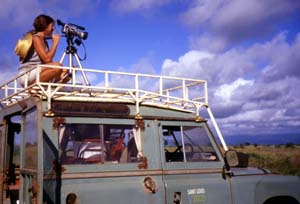A new, award-winning movie set in Kenya features African drums, jazz piano, a beautiful narration, chase scenes — of sorts — and even lots of nudity in the form of blind naked mole-rats.
More importantly, though, it’s a movie with a message: how to treat wild animals captured for scientific study in a humane, safe way.

Rosie Koch, a graduate student in the Division of Biological and Biomedical Sciences, and Stan H. Braude, Ph.D., lecturer in biology in Arts & Sciences, won the 2004 Jack Ward Film Award, noncommercial category, from the Animal Behavior Society of America for their short documentary, All the Trappings.
The film was also featured at the St. Louis Film Festival. Jane Phillips-Conroy, Ph.D., professor of anatomy in the School of Medicine and of anthropology in Arts & Sciences, narrates the 15-minute film.
Braude is a specialist in blind naked mole-rats, natives of the semi-arid region of Africa comprising Kenya, Ethiopia and Somalia. These 3-4-inch creatures are, indeed, blind and hairless all their lives. They’re so ugly, they’re cute.
Mole-rat as cultural icon
Many American children know about this species because a naked mole-rat named Rufus is a hero on the Disney cartoon Kim Possible. Unlike the cartoon, All the Trappings tells the equally amazing adventure of studying these animals in the wild.
Discovered just 100 years ago, blind naked mole-rats are eusocial — like bees and termites, for instance, their community revolves around a breeding queen and her workers. Blind naked mole-rats tunnel beneath the soil and live in a network of burrows that can extend for miles long.
Braude has been studying the creatures in Kenya since 1985. He noticed that local Kenyans trapped the animals with a traditional, double-bladed African garden hoe, which killed as many animals as they dug up, also ruining the infrastructure of the habitat.
In 1987, Braude, the only researcher in the world studying blind naked mole-rats in the wild, developed an electronic trap that would avoid the needless killing and destruction.
“It’s a very sensitive trap that does minimal disturbance to the underground burrow system,” Braude said. “The old way resulted in death or injury to more than half the animals in the habitat. With my system, we can capture whole colonies in a short period of time.”
The body of the trap is a plastic tube that is the same diameter as the rats’ tunnels. A sliding shutter door cuts off the animal’s escape, the door releasing when the animal is completely inside the tube. All Braude has to do after the capture is place the animal in a bucket. He’ll take data such as length, weight and date captured, and he’ll then band the animals before releasing them in their original habitat.
The animals can live into their 20s, with the oldest that Braude has studied being 18.
First, find the mound
The first step to capture blind naked mole-rats is to locate a colony that is excavating tunnels. The animals throw excess soil onto the surface, generating mounds that look like erupting volcanoes.
Braude and his assistants can capture an entire colony without digging up more than several yards of the tunnels near the surface.
Using his traps, Braude has captured and released more than 9,000 blind naked mole-rats for nearly 20 years. Some of the animals he marked and released in 1986 are alive today.
All the Trappings shows Braude and an assistant employing his method, plus another, above-ground one involving shallow, plastic-lined trenches placed beneath walls that force the animals to go left or right and tumble harmlessly into the trenches. Because of these safe practices, Braude has observed evidence of kidnapping and enslavement by colonies of rats. He also has been able to observe dispersal from their original colonies, traveling as far as a mile or so away from their original homes.
Braude made a crude video of his work some years ago, but asked Koch, who has an interest in videography, to make a higher-quality one. Koch has just defended her doctoral thesis, which focused on the dispersal of the animals as well as their endocrinology.
One of her findings is that trapping the animals doesn’t raise the level of corticosterones. High corticosterone levels are an indication of stress. There’s no indication that trapping them stresses them in the least.
Koch has just accepted a position with Story House Productions in Berlin, where she will be involved in making science documentaries.
“It was a lot of fun to think of ways to create pictures of the trapping process that we go through many times each year,” Koch said. “I tried to capture the excitement of catching the first naked mole-rat of a colony, and show how new methods help us learn more and more interesting things about them.
“It is a great honor to receive the award from the Animal Behavior Society, and the award certainly serves as a big motivation for future projects of this kind.”